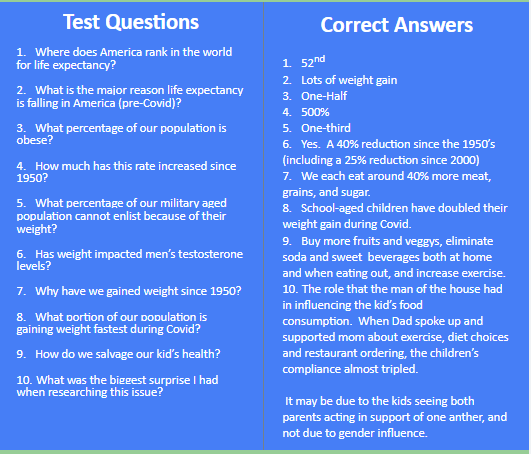How many of these surprising facts disclosed in my columns of January 1 and January 15 do you know?
As you see above, school-aged kids are the most at-risk population for excessive unhealthy weight gain. The school absentee rate of overweight and obese students is between 27% and 54% higher than normal weight students.[1] How does this impact their education? Let me count the ways….
Nationally, this group is four times more likely to develop diabetes,[2] almost twice as likely to experience mental health issues such as depression and anxiety[3] and is between 25% and 50% more likely to have asthma.[4][5] Vitamin D deficiency is common in children with obesity, with reported prevalence rates as high as 90%.”[6] Half of all children who have vitamin D deficiency experience lifelong hearing loss because the tiny bones in the inside of their ears have not grown correctly.[7]
They miss much more school than their slimmer fellow students, score lower on standardized tests, and are much more likely to drop out of school before graduating high school. And if they do graduate, due to lower grades, they are much less likely to qualify for scholarships to higher education. Their life trajectory is altered forever, solely because of lack of adult leadership in the areas of diet and exercise. The problem can be fixed – but not by the kids.
This creates a real challenge for the North Carolina school systems because the professional evaluations of administrators and teachers are based on how well kids learn. North Carolina is the 9th largest public school system in America and ranks 29 out of the 50 states in K-12 public education success. [8][9] How much of that is due to adults failing to provide leadership about students’ diet and exercise habits? Most of it. The kids are not the ones who control what the family is served at meals and snacks.
If our state’s school systems are going to be able to increase student learning, more than one-in-four of their students have to lose weight.[10][11] And the schools cannot bring the subject up with parents without risking criticism. This is a trap.
How do we fix this mess? We get the adults who parent, and those who educate, to step up and cooperate toward a common goal.
There is a great set of already invented, researched and proven successful material available for the team to work with both at home and in school.
One example is a study of 1,368 students in the Los Angeles Unified School District that provided a simple five week middle-school program and compared obese students who participated in the program to students who did not. Results two years later showed the kids who participated weighed around 9 pounds less than those who did not participate.[12]
Another great example being used by teachers is a set of math exercises based on real-life food and sports figures. You can see a whole workbook of these teaching tools by googling (this is not a typo – just copy it exactly as written): “New-tritional inf how long does it take to burn off food from McDonalds”.
There is also a huge library of such curriculum material available by googling “nutrition.gov kids’ corner” that can be worked into already existing lessons.
In these success stories, two kinds of education are occurring at once. The student learns to solve math problems based on burning energy or consuming calories. In addition, they learn about how their body absorbs and uses what they eat. A win/win.
We have a problem with our culture. Over time, what used to be considered unusual has become a new normal. A woman who wore a size 16 dress in 1958 now buys a size 8 – without losing a pound![13] The change occurred so gradually, so that the change, while important, is invisible. And socially risky to bring up.
Saving our nation’s children will require teamwork between grandparents, parents, neighbors (have an unused basketball hoop to pass along?), churches and schools. This will not happen unless we remove the taboo around talking about the epidemic of obesity.
We have to make the invisible taboo visible – and it will be a challenge. Mature leadership is needed. Can you rise to meet this challenge, for the sake of the kids’, and our country?
Authored by Francis Koster Ed. D
[1] https://pubmed.ncbi.nlm.
[4] https://pubmed.ncbi.nlm.
[5] https://www.jacionline.
[6] https://www.uchealth.com/
[7] https://pubmed.ncbi.nlm.
[9] https://wallethub.com/
[11] https://www.cdc.gov/
